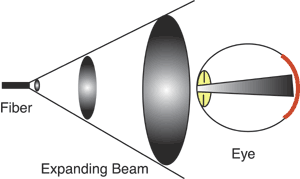Fiber optic cables are now widely employed for the purpose of enhancing voice and data communication in many different applications. The flexibility of the technology is extraordinary, and advances in methods of communication have revealed even more uses for fiber optics. However, not all people, who install or maintain fiber optic cables, take proper safety precautions to avoid the hazards caused by fiber optics. Sometimes they just ignore the potential dangers of optical fiber. Unfortunately, accidents occur because of this neglect. This article will emphasize on introducing some common hazards that come with fiber optic installations and offering rules for safe installation.
The part will describe elements involved in safety protection issues when working with fiber optics. These are eye safety, bare fiber safety and other considerations for safety.
Many people are concerned that the most dangerous part of fiber-optic work was the chance you might get your eyes harmed by laser light in the fiber. However, in fact, most fiber-optic systems do not have sufficient power to cause harm to your eyes and the light coming out of a fiber is expanding, so the farther you are away from the end of the fiber, the lower the exposure.

However, it’s not a good idea to look into a fiber unless you know no source is being transmitted down it. You should always check the fiber with a power meter before examining it. The real issue of eye safety is getting fiber scraps into the eye. During the process of termination and splicing, you will be continually exposed to small scraps of bare fiber. And these scraps are very dangerous. Once they get into your eyes, they are very hard to flush out and will probably lead to a trip to the emergency room at the hospital. Whenever you are working with fiber, wear safety glasses!
The fibers themselves are a very serious hazard since they are small pieces of glass. If possible, use a dark plastic mat for a work surface, which will make it easier to see the fibers you are working with and handle them more carefully.
When trimming, stripping, or cutting fibers, tiny fragments can penetrate the skin and become embedded, causing a serious irritation. Ingested fibers can cause internal damage since they are light enough to float in air. Because of this, workers should not eat or drink in a fiber optic work area since a fiber scrap could fall onto their food or in their drink.
Fiber optic splicing and termination use various chemical cleaners and adhesives as part of the processes. And these substances should be properly handled. Note that fusion splicers use an electric arc to make splices, so one should ensure no flammable gases are contained in the space where fusion splicing is done. Smoking should not be allowed around fiber optic work.
- Keep all food and beverages out of the work area in case fiber particles are ingested
- Wear disposable aprons to minimize fiber particles on your clothing. Fiber particles on your clothing can later get into food, drinks, and/or be ingested by other means.
- Always wear safety glasses with side shields and protective gloves. Treat fiber optic splinters the same as you would glass splinters.
- Never look directly into the end of fiber cables until you are positive that there is no light source at the other end. Use a fiber optic power meter to make certain the fiber is dark. When using an optical tracer or continuity checker, look at the fiber from an angle at least 6 inches away from your eye to determine if the visible light is present.
- Only work in well ventilated areas.
- Contact wearers must not handle their lenses until they have thoroughly washed their hands.
- Do not touch your eyes while working with fiber optic systems until they have been thoroughly washed.
- Keep all combustible materials safely away from the curing ovens.
- Put all cut fiber pieces in a safe place.
- Thoroughly clean your work area when you are done.
- Do not smoke while working with fiber optic systems.
In conclusion, the awareness of safety should be raised among fiber optic installers, and each technician must adopt the best practices for safe handling of all fiber optic components to preserve the safe environment. Hope these simple fiber optic safety rules can contribute to building a healthy and sound work space.
